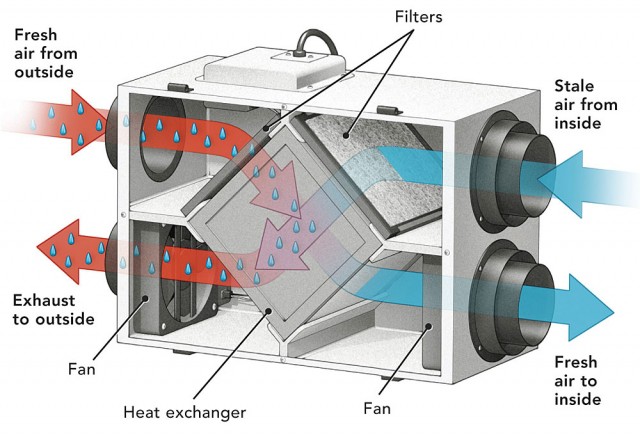How HRV Reduces Risks of Mold and Indoor Damage
Wiki Article
The All-Inclusive Overview to the Uses of Heat Recovery Ventilation in Modern Structures
Heat Recovery Ventilation (HRV) systems represent a substantial development in constructing innovation (HRV Heat Recovery Ventilation). They give a method for trading stagnant indoor air with fresh exterior air while reducing power loss. This method not just enhances indoor air top quality however additionally contributes to energy performance in both property and commercial structures. Understanding the various applications and advantages of HRV can reveal its important role in contemporary layout and sustainability initiatives. The implications of this innovation deserve discovering furtherUnderstanding Heat Recovery Ventilation Solutions

Lots of modern-day buildings prioritize energy effectiveness, comprehending warm recuperation air flow (HRV) systems is vital for enhancing indoor air high quality and lowering power consumption. HRV systems work by moving heat from stagnant interior air to inbound fresh air, properly preserving comfy interior temperatures while lessening power loss. These systems contain a warmth exchanger, followers, and ductwork that assist in the flow of air. During winter season, HRV units record and recycle warm from the outgoing air, while in summer, they can aid cool down incoming air. By continually trading air, HRV systems also reduce moisture and the concentration of indoor toxins. Correct setup and maintenance of HRV systems are essential for their efficiency and performance in improving overall structure efficiency and comfort.
Advantages of Heat Recovery Ventilation
Heat recovery ventilation systems provide numerous advantages that enhance both power effectiveness and indoor air top quality in modern-day buildings. By catching and reusing power from exhaust air, these systems significantly decrease heating and cooling prices, bring about lower energy intake. They keep a steady flow of fresh exterior air, reducing the danger of interior air pollutants and irritants. This constant exchange helps manage humidity levels, stopping mold growth and making sure a much healthier living environment. Furthermore, HRV systems add to sustainability goals by decreasing general carbon impacts. Their capacity to optimize ventilation without giving up thermal convenience makes them a valuable enhancement to modern building layout, promoting both financial and ecological advantages.Applications of HRV in Residential Buildings
As home owners progressively prioritize energy effectiveness and interior air top quality, the applications of warmth recovery ventilation (HRV) systems in property structures have actually come to be more common. HRV systems are specifically beneficial in firmly secured homes, where preserving fresh air circulation is necessary for avoiding dampness buildup and indoor pollutants. They successfully move heat from outbound stagnant air to incoming fresh air, reducing energy expenses connected with heating & cooling. In addition, HRVs can enhance comfort levels by managing moisture and temperature level. They are additionally versatile for numerous household layouts, consisting of single-family homes and multi-unit structures. In general, integrating HRV systems supports sustainable living techniques while making certain a healthier indoor setting for owners.HRV in Commercial and Industrial Settings
In industrial and industrial settings, the implementation of heat recovery ventilation (HRV) systems has become progressively important for enhancing energy performance and maintaining air quality. These systems successfully move warmth from exhaust air to inbound fresh air, minimizing the demand for extra heating or cooling. This not only decreases power expenses but also adds to sustainability efforts. Industries such as manufacturing, warehousing, and office structures benefit substantially from HRV systems, as they assist manage temperature and moisture levels, making certain a comfortable and effective atmosphere. HRV systems aid in getting rid of contaminants and excess wetness, enhancing indoor air top quality. As guidelines around air quality end up being stricter, the adoption of HRV modern technology is likely to expand, making it a critical part of modern-day industrial and industrial framework.Future Patterns in Heat Recovery Ventilation Innovation

Regularly Asked Concerns
Exactly How Does Heat Recovery Ventilation Effect Indoor Air High Quality?
Heat recovery ventilation significantly enhances interior air high quality by continually exchanging stale interior air with fresh outside air while recovering energy. This process minimizes toxins, maintains ideal humidity levels, and assures a healthier atmosphere for owners.Can HRV Systems Be Mounted in Existing Buildings?
HRV systems can undoubtedly be installed in existing buildings. Retrofitting might require modifications to ductwork and air flow formats, but it considerably improves power efficiency and interior air high quality, making it a viable option for older frameworks.What Upkeep Is Required for HRV Equipments?

Exist Specific Climates Where HRV Is Much More Efficient?
Heat recovery ventilation systems are particularly efficient in environments with significant temperature level differences between seasons. These systems enhance energy effectiveness by recovering warm from exhaust air, making them perfect for both cold and reasonably cozy atmospheres.Just How Do HRV Systems Affect Energy Expenses?

Report this wiki page